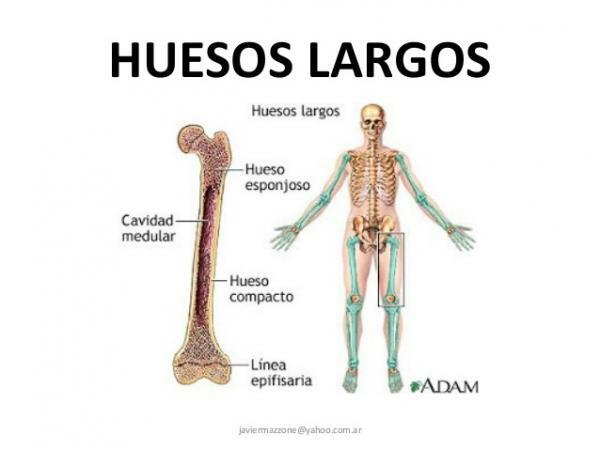Discover what are the long bones of the human body

Image: Answers.tips
Our skeleton is made up of different bones, from the skull to the phalanges. As you may have seen, they are not all the same: some longer, some shorter, some more regular, some flatter, etc. In this lesson from a TEACHER we are going to see one of these classes, we will study what are the long bones of the human body and we will list some examples.
To study the bones of the human body one of the ways to classify them is according to their shape. Keep in mind that they are long not because of its size, if not because of itsshape. Bones such as the phalanges of the fingers are also considered long bones despite their small size. They are bones with a more or less cylindrical shape, that is, elongated. They are long and narrow bones.
What are long bones for?
Long bones are dense and strong, which will allow them to have a lot of resistance and that we can, for example, bear the weight of our body when walking. In addition to the support function, the long bones - together with the irregular and short bones - will have
locomotive function (of movement), so they have to be resistant to wear.Inside the long bones we can distinguish three parts. If we imagine long bones as a tube we will find: the two ends of the tube (epiphysis), which are responsible for joining muscles, joints or other bones, and the central part of the tube (diamphasis). Within the diaemphasis is the medullary canal owns the yellow bone marrow, which forms blood cells.

Image: Slideshare
If you look at your own body you will realize which are the long bones of the body, is your arm bone elongated? Is your skull? And your knee? If you keep comparing you will realize that the long bones of the human body are in the extremities, that is, on the arms and legs. Next, we will see some examples of what the long bones of the body are. Remember
1. The femur
The femur is in the thigh. It is the largest long bone, not only in humans, but in the vast majority of mammalian animals. To give you an idea, in the human, it is about a quarter the size of the height of the individual. It is a strong bone and it is also the most voluminous in the whole body and numerous muscles are anchored to it.
2. The tibia and fibula
The tibia It is located on the inside of the leg. It joins or articulates with the femur and the fibula, which is on the outer side of the leg. Both are elongated in shape and large.
3. Humerus
The humerus is the bone that joins the elbow with the shoulder, that is, the one in the upper arm (forearm). It is the equivalent of the femur in the arm, making it the largest long bone in the arm.
4. The ulna and radius
The ulna and the radio They are the equivalents of the tibia and fibula in the arm. These bones articulate with the humerus (forearm) and the carpal bones of the hand. If you put your arms outstretched, close to the body and with the palms up, the ulna runs along the inner arm (closer to the body), and the radius the outermost part of the body (further away from the Body).
5. Phalanges
The phalanges are the bones that form the fingers of the hands and feet. There are 5 in each hand and foot and each has three portions in each phalanx (proximal, medial and distal) except the thumb, which is shorter and only has a proximal and distal portion. These bones are elongated so, despite their small size, they are long bones.
6. The metacarpus
The metacarpus consists of the five metacarpal bones that are thin and slightly elongated and occupy the entire palm of the hand. Therefore, to go from being small they are also elongated.
7. Metatarsal
The metatarsus It is the equivalent of the metacarpus in the foot, that is, it is a set of five bones that articulate with the phalanges of the toes and the bones that form the upper part of the foot. Together with the tarsi they form the instep of the foot.
8. The ribs
The ribs, especially the fake ribs (ribs VIII-X), are bones with an elongated shape so they can be considered long bones. The false ribs are just above the floating ribs and are the longest.
In this case, the ribs do not have a supporting or locomotive function, but are the only long bones that have a protective function. This is because they form the rib cage, which surrounds the chest and whose function is to protect the organs. internal thorax (mainly lungs and heart) while allowing its expansion during the breathing.
Do you have any questions or contributions about the long bones of the body? Let us know in the comments section, we are waiting for you!

Image: Typesde.com



